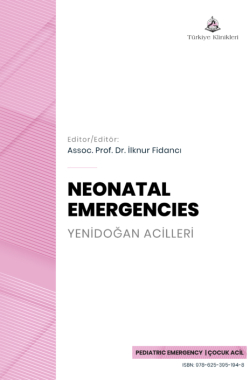Neonatal Gastrointestinal and Surgical Emergencies
Özkan CESURa
aUniversity of Health Sciences Ankara Training and Research Hospital, Department of Pediatric Surgery, Ankara, Türkiye
Cesur Ö. Neonatal gastrointestinal and surgical emergencies. In: Fidancı İ, ed. Neonatal Emergencies. 1st ed. Ankara: Türkiye Klinikleri; 2024. p.40-5.
ABSTRACT
Gastrointestinal (GI) emergencies seen during the neonatal period present challenges that necessitate prompt recognition and management. The most of them are unique disorders like esophageal atresia and anal atresia. Neonatal GI emergencies had certain clinical scenarios such as malrotation with mid gut volvulus, necrotizing enterocolitis (NEC), congenital diaphragmatic hernia (CDH), and Hirschsprung’s disease encompass a spectrum. They often present with symptoms such as abdominal distension, bilious vomiting, delayed passage of meconium, bloody stools, and respiratory distress. A number of advanced imaging techniques such as abdominal radiography, ultrasonography and contrast studies play a crucial role in confirming the diagnosis and determining the appropriate management. In conclusion, neonatal GI emergencies necessitate heightened clinical awareness and a multidisciplinary approach. Early recognition of common clinical symptoms and red flags is critical for timely intervention. Prompt intervention via medical or surgical management is often necessary to improve patient outcomes.
Keywords: Infant, newborn, diseases; gastrointestinal diseases; emergencies; surgery
Kaynak Göster
Referanslar
- Laje P. Abdominal Surgical Emergencies in Neonates. Neoreviews. 2023;24(2):e97-e106. [Crossref] [PubMed]
- Sylvester KG, Liu GY, Albanese CT. Necrotizing Enterocolitis. Pediatric Surgery. 2012:1187-207. [Crossref]
- Ergenekon E, Tayman C, Özkan H. Turkish Neonatal Society Necrotizing Enterocolitis Diagnosis, Treatment and Prevention Guidelines. Turk Arch Pediatr. 2021;56(5):513-24. [Crossref] [PubMed] [PMC]
- Hudson JA, Byrns S, Nizalik E, Ferretti E. Case report: necrotizing enterocolitis with a transverse colonic perforation in a 2-day old term neonate and literature review. Matern Health Neonatol Perinatol. 2021;7(1):4. [Crossref] [PubMed] [PMC]
- Hackam D, Caplan M. Necrotizing enterocolitis: Pathophysiology from a historical context. Semin Pediatr Surg. 2018;27(1):11-18. [Crossref] [PubMed] [PMC]
- Donda K, Bose T, Dame C, Maheshwari A. The Impact of MicroRNAs in Neonatal Necrotizing Enterocolitis and other Inflammatory Conditions of Intestine: A Review. Curr Pediatr Rev. 2022;19(1):5-14. [Crossref] [PubMed]
- Aurora M, Keyes ML, Acosta JG, Swartz K, Lombay J, et al. Standardizing the Evaluation and Management of Necrotizing Enterocolitis in a Level IV NICU. Pediatrics. 2022;150(4):e2022056616. [Crossref] [PubMed] [PMC]
- Dingemann C, Eaton S, Aksnes G, Bagolan P, Cross KM, De Coppi P, et al. ERNICA Consensus Conference on the Management of Patients with Esophageal Atresia and Tracheoesophageal Fistula: Diagnostics, Preoperative, Operative, and Postoperative Management. Eur J Pediatr Surg. 2020;30(4):326-36. [Crossref] [PubMed]
- Garfield K, Sergent SR. Pyloric Stenosis. In: StatPearls [Internet]. Treasure Island (FL): StatPearls Publishing; 2023 Jan-.
- Goring J, Murthi GVS. Intestinal Obstruction. In: Godbole P, Wilcox D, Koyle M, eds. Guide to Pediatric Urology and Surgery in Clinical Practice. Springer, Cham; 2020. p. 169-76. [Crossref]
- Parrado RH, Ostlie DJ. Intestinal Atresia and Webs. In: Lacher M, St Peter SD, Zani A, eds. Pearls and Tricks in Pediatric Surgery. Springer, Cham; 2020. p. 161-7. [Crossref]
- Gaillard F, Murphy A, Campos A, et al. Intestinal malrotation. Reference article, Radiopaedia.org [Internet]. Radiopaedia Australia Pty Ltd. ©2005 [cited: Sep 09, 2023]. Available from: [Link]
- Kyrklund K, Sloots CEJ, de Blaauw I, Bjørnland K, Rolle U, Cavalieri D, et al. ERNICA guidelines for the management of rectosigmoid Hirschsprung's disease. Orphanet J Rare Dis. 2020;15(1):164. [Crossref] [PubMed] [PMC]
- Wilson BE, Etheridge CE, Soundappan SV, Holland AJ. Delayed diagnosis of anorectal malformations: are current guidelines sufficient? Journal of paediatrics and child health. 2010;46(5):268-72. [Crossref] [PubMed]
- Mowrer AR, DeUgarte DA, Wagner AJ. Abdominal Wall Defects: A Review of Current Practice Guidelines. Clinics in Perinatology. 2022;49(4):943-53. [Crossref] [PubMed]
- Jancelewicz T, Brindle ME, Guner YS, Lally PA, Lally KP, Harting MT, et al. Congenital Diaphragmatic Hernia Study Group. Toward standardized management of congenital diaphragmatic hernia: an analysis of practice guidelines. J Surg Res. 2019;(243):229-35. [Crossref] [PubMed]

